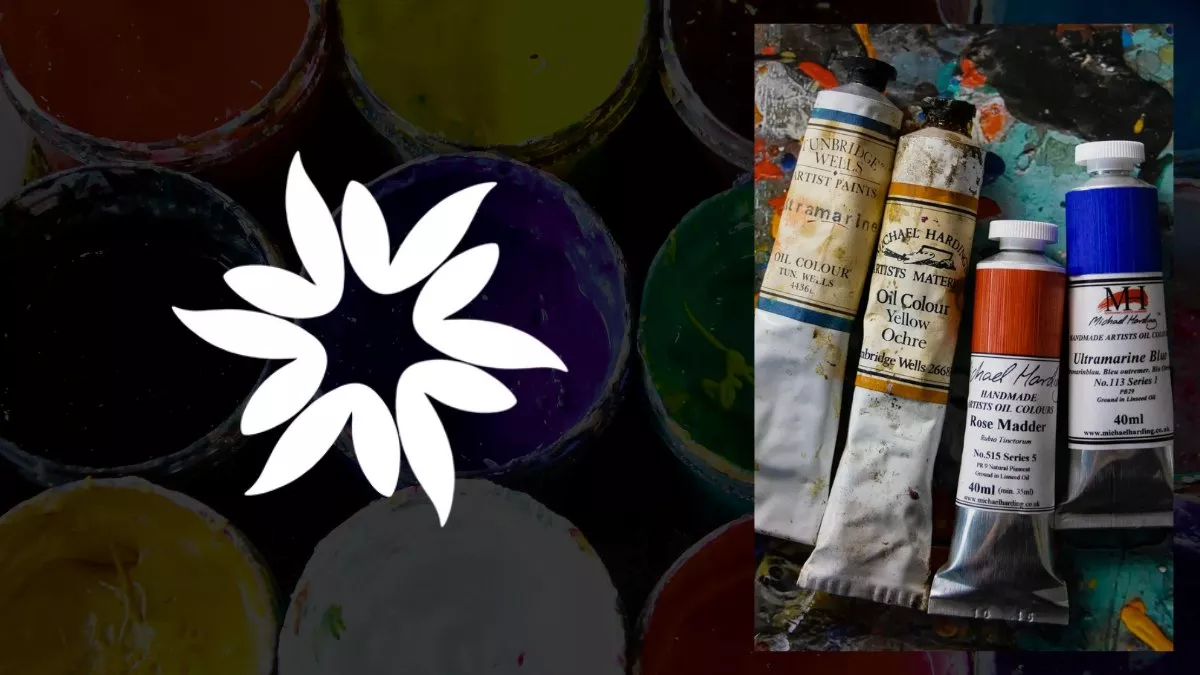If you’re just getting into painting, you might not think much about the brand of oil paint you’re using.
You probably just grabbed the first set you found, thinking all oil paints are basically the same, right? Well, not quite!
There’s a big difference between brands, and some are preferred by the most famous artists out there.
Are you curious to know which brands are considered the best? Let’s jump in and see what makes them special!
Key Takeaways
- Not all oil paints are the same—each brand has its own texture, color quality, and price, so picking the right one can really enhance your painting.
- Beginners and pros have different needs—affordable brands like Winsor & Newton are great for learning, while high-end brands like Michael Harding offer richer colors for detailed work.
- Eco-friendly options exist, too—brands like Gamblin are perfect if you care about the environment and want to avoid harmful chemicals without sacrificing quality.
1. Michael Harding
Michael Harding oil paints are highly valued because they have a lot of pigment and no fillers, so professional artists love them for their bright, long-lasting colors.
Importantly, each tube is handmade, guaranteeing consistent quality, which means strong pigmentation and resistance to fading.
One of the features of these paints is their smooth, buttery texture, which makes them easy to apply and blend.
However, as you may expect, they are more expensive, which reflects their professional quality.
Naturally, artists appreciate that these paints cover well and last long, so they can get rich colors without using too much paint.
It’s worth noting that some colors, especially browns, are a bit stiffer, but this is common in paints with high pigment.
Although the color selection is smaller than other brands, the pigments are carefully chosen to meet traditional and modern artistic needs.
2. Winsor & Newton (Winton Series)
The Winsor & Newton Winton Series is popular for students and beginners because it is more affordable without sacrificing quality.
Though these are student-grade oil paints, they still have decent pigmentation, which makes them suitable for learning techniques and creating bright artwork.
The paint’s creamy texture makes it easy to use, whether you want smooth coverage or visible brushstrokes.
One big advantage of the Winton series is its low cost, which allows beginners to try oil painting without spending a lot.
On top of that, the paint’s lightfastness means the colors will stay bright over time, and while the color range is smaller than professional options, it’s still enough for most new artists.
However, because Winton paints have less pigment than higher-end brands, they might not be as intense or cover as well.
Still, they are a popular choice because of their reasonable price, dependable consistency, and ease of use.
3. Gamblin
Gamblin oil paints are known for being eco-friendly and offering a wide selection of traditional and modern colors.
Amazingly, the company focuses on reducing its environmental impact, such as recycling pigments during production.
The handy thing about Gamblin is that they have both professional and beginner paints, so they work for many types of artists.
More importantly, these paints are praised for their rich pigmentation and smooth application.
While the texture can vary—especially in earth tones, which can be stiffer—the quality is reliable.
Notably, Gamblin uses safflower oil, which dries slower than linseed oil, giving artists more time to work on their paintings.
So this feature makes them popular with those who like to rework their art over several days.
Despite slight differences in consistency, especially with earth tones, Gamblin’s high quality and ethical production make them a solid choice for beginners and professionals.
4. Old Holland
Old Holland is one of the oldest paint oil manufacturers in the world, with a history dating back to 1664.
They are well-known for sticking to traditional paint-making methods, using the best pigments and cold-pressed linseed oil.
Remarkably, these paints are made following recipes used by Dutch master painters from centuries ago.
The high concentration of pigments in Old Holland paints results in deep, vibrant colors that are long-lasting. So, it’s needless to say, this makes them a popular choice among professional artists who want rich and durable hues.
However, Old Holland paints are quite stiff straight from the tube, making them hard for some artists to work with. Thus, many painters mix in mediums like linseed oil or turpentine to make the paint more fluid.
Aside from their thicker consistency, they are ideal for impasto, where artists apply paint in thick layers and make visible brushstrokes.
Although expensive, many artists find the strong coverage and ability to resist fading over time worth the cost.
On the other hand, the slow drying time and need for added mediums can be inconvenient for those who prefer quicker, more fluid painting styles.
5. Sennelier
Sennelier, a French paint brand with over 130 years of history, is famous for its high-quality oil paints favored by renowned artists like Picasso and Van Gogh.
The paint is known for its smooth, creamy texture, making it easy to blend and mix.
Many artists often enjoy how easily Sennelier paint glides across the canvas, which gives their work a rich, velvety finish.
And this smooth application is one of the reasons why Sennelier has remained a favorite in the art world.
A key feature of Sennelier oil paints is their vibrant color. Since these paints are made with top-notch pigments, you don’t need much to achieve bold, bright hues.
Also, the paints are highly resistant to fading, so the colors stay vibrant for years.
Another benefit is their slow drying time, as this allows artists to work on their paintings over several days without the paint hardening too quickly.
This slow-drying nature, along with the smooth consistency, makes Sennelier paints perfect for detailed work and glazing techniques.
6. Williamsburg
Williamsburg oil paints are admired for their wide range of colors and unique textures, which come from their small-batch, handmade production process.
Ultimately, these paints offer a rich selection of earth tones and modern pigments, giving artists plenty of options for creative expression.
Founded by artist Carl Plansky, Williamsburg originally aimed to recreate the look and feel of old-world pigments.
Today, the company continues this tradition, providing artists with paints rich in color and texture.
Williamsburg paints’ texture varies depending on the pigment used, often resulting in a gritty feel. Because of this, they’re ideal for techniques where the texture of the paint is important, such as impasto.
Typically, artists who enjoy using palette knives or creating thick, textured surfaces appreciate the weight and density of these paints.
Despite their high price, Williamsburg paints’ quality and pigment load offer excellent coverage and lasting color, making them a worthwhile investment for serious artists.
7. M. Graham
M. Graham’s oil paints stand out because they use walnut oil instead of the more common linseed oil as a binder.
And this gives them a few key advantages, such as better resistance to yellowing, helping the colors stay bright and true for longer.
For artists who want their work to maintain its original brilliance over time, this is a major benefit.
Additionally, walnut oil slows down the drying process, which is helpful for those who use wet-on-wet techniques or prefer to work on their paintings over several days—without the paint drying too quickly.
Because of the walnut oil, M. Graham can pack more pigment into their paints, resulting in richer and more saturated colors.
Essentially, you don’t need to use as much paint, as a small amount goes a long way.
One of the best things about M. Graham is that their paints have a smooth, buttery texture, making them easy to use straight from the tube.
However, some artists prefer to mix in a medium like M. Graham’s Walnut Alkyd to speed up the drying time.
Not to forget, these paints are solvent-free, making them a safer option for artists working in small spaces or those who want to avoid harmful chemicals, which is ideal for detailed work that requires focus over long periods.
8. Holbein
Holbein, a Japanese brand, is known for producing high-quality oil paints favored by professional and serious amateur artists.
Their paints are praised for their smooth consistency and vibrant colors, which make them perfect for fine detail work and techniques like glazing.
Holbein carefully avoids using fillers or extenders in its paints, ensuring the colors remain true and consistent with every use. So, this is highly valued by artists seeking precision in their work.
One key feature of Holbein oil paints is their extensive color range, which offers traditional and modern pigments.
These highly lightfast colors resist fading and help the artwork retain its vibrancy over time.
And the finely milled, creamy texture of Holbein paints allows them to spread smoothly on the canvas, making blending and mixing easy.
With their high pigment load and versatile texture, these paints are suitable for thick, textured techniques like impasto and thin, transparent layers in glazing.
Also, Holbein paints are solvent-free, making them a safer option for artists who need to work long stretches without exposure to harmful chemicals.
9. Blockx Oil Paints
Blockx, a European brand established in 1865, is known for its handmade oil paints that stick to traditional methods.
What makes Blockx stand out is the use of poppy seed oil as a binder, especially in its blues and whites, which helps prevent yellowing over time.
This binder also gives the paints a buttery texture, making them easy to apply smoothly, which is great for artists aiming for subtle color blends.
In fact, the slower drying time of poppy seed oil makes Blockx paints perfect for techniques like wet-on-wet or alla prima, where the paint needs to stay workable for longer.
Blockx paints are carefully ground using stone mills, which helps maintain the vibrancy and purity of the pigments without overheating them.
Although their range is smaller compared to some other brands, with 87 colors, every shade is designed with excellent lightfastness, so the colors won’t fade easily.
Blockx binds its earth tones and darker colors in linseed oil, while more delicate colors, like blues and whites, are mixed with poppy seed oil to maintain their stability and brilliance over time.
10. Cranfield Oil Paints
Cranfield, a UK-based brand, is well-regarded for producing high-quality oil paints known for their rich pigmentation and smooth texture.
The paints are highly lightfast, with most colors earning top ASTM I or II ratings, meaning they resist fading over time.
Given these qualities, Cranfield is a reliable choice for professional artists who want their work to last, preserving its vibrancy for years.
One of Cranfield’s standout features is its affordability since it offers professional-grade paints at prices lower than premium brands like Old Holland or Blockx.
Importantly, the paints come in larger tube sizes, such as the 225 ml option, which is especially handy for frequently used colors like titanium white.
With their buttery consistency, Cranfield paints are easy to blend and layer directly from the tube, making them a go-to option for students and professionals seeking consistent quality at a reasonable price.
Why Use Oil Paints?
Oil paints have stayed a favorite for artists for hundreds of years because of their special qualities.
Here’s why artists still love using them:
1. Vibrant and Rich Colors
Known for their bright, bold colors, oil paints are famous for their high pigment content, which ensures the colors stay rich and don’t fade as they dry.
With this in mind, creating stunning and realistic effects becomes much easier, especially when showing light and shadow.
2. Slow Drying Time
Fortunately, oil paints take a long time to dry, giving artists plenty of time to work with them. And this flexibility lets you blend and adjust details easily without rushing.
You can even fix mistakes or come back to parts of the painting days later.
Ultimately, this slow drying time also works great for glazing or adding texture.
3. Versatile Application
Interestingly, oil paints can be used in many different ways. You can apply them thick for texture or thin for smooth, delicate effects.
It’s great that you can work with them using brushes, palette knives, or even your fingers.
Plus, oil paints mix well with other materials, like acrylics or wax, so you can really get creative with them.
4. Durability and Longevity
As you may already know, oil paintings can last hundreds of years if cared for properly.
Unlike some other types of paint, the colors stay rich, and the paint doesn’t crack or fade over time.
So, it’s no surprise that oil paints are an excellent choice for creating timeless, long-lasting artwork.
5. Blending and Texture
Because oil paints dry slowly, they’re perfect for blending colors directly on the canvas.
You can create smooth transitions and subtle gradients that are harder to achieve with faster-drying paints like acrylics.
Additionally, oil paints also have a thick, creamy texture, letting artists create bold brushstrokes and textures.
6. Correcting Mistakes
The great thing about oil paints is that if you make a mistake, fixing it is a breeze.
You can scrape the paint off or simply paint over it.
And that’s what makes oil paints a forgiving choice, especially for beginners still finding their way.
7. Depth and Light Effects
Importantly, oil paints are fantastic for capturing light and adding depth to a painting.
When applied in layers, they create a glowing effect that makes the artwork come alive.
That’s why oil paints are often preferred for realistic portraits and landscapes.
Start Painting Like a Pro with the Best Oil Paint Brands
As we’ve discussed, choosing the right materials can make all the difference in elevating your art.
So, painting like a pro is within reach with the best oil paint brands. Therefore, give these brands a shot, and you’ll notice a significant change in your artwork.
Just think about how awesome it’ll be to blend smooth, creamy colors that glide on your canvas or add tiny details with paints that work just the way you want.
Each brand we talked about has its own cool features that can fit your style, so you’ll definitely find one that clicks with you.
So go for it—grab a tube of Michael Harding for those deep colors, give Winsor & Newton a shot for that creamy feel, or check out Gamblin if you care about eco-friendliness.
And don’t be afraid to try different brands to see what works best for you! It’s all about experimentation.
With the right paints in your hands, you’ll be on your way to making amazing art that shows off your creativity.








